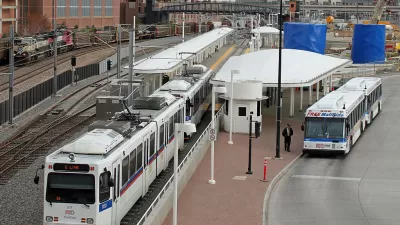Josh Barro provide examples galore of why the answer to that question isn't always yes—where costly rail investment has been to the detriment of existing transit. His column targets proposed projects, such as New York's LaGuardia Airport AirTrain.

"Bus-based public transit in the United States suffers from an image problem," writes Barro. "That fact, laid out in a 2009 report from the Federal Transit Administration, isn’t surprising, but it has led to a perverse outcome."
- Gov. Andrew Cuomo’s proposed AirTrain link from La Guardia Airport in New York could be the latest example. It might cost $450 million or it might be more like $1 billion—the M.T.A. head Tom Pendergrast wavered between the figures in a public hearing last month—but either way, from most places in New York City, it won’t be faster than taking existing bus service to the airport, because it will run southeast from the airport, away from Manhattan
- In California, Bay Area Rapid Transit spent nearly half a billion dollars to build a three-mile rail connector to the airport in Oakland, which opened last year; it saves about 3,000 daily riders four minutes over the shuttle bus service it replaced
Barro is hardly the first to question costly airport connectors—one of the best columns I've seen comes from Market Urbanism in 2010 by Stephen Smith, now editor of New York Yimby. Barro has a larger audience to spread the "rail isn't always better" message.
However, to effectively question rail as always being the best transit investment, it's necessary to point to worthy bus projects. "The Massachusetts Bay Transit Authority has had modest success getting people to ride buses (the "Silver Line") from downtown to the airport; from most points in Boston, that trip also involves a train to the bus to the plane," writes Barro.
Benjamin de la Peña and Nicholas Turner, both formerly with The Rockefeller Foundation's urban development division, penned a July 2013 Planetizen Exclusive that describes other worthy bus projects throughout the United States.
Barro questions streetcar investments in recently opened systems and those still in the planning phase.
- Atlanta’s downtown streetcar loop was a relative bargain at $100 million; unfortunately, Rebecca Burns, a writer at Atlanta magazine, took it to work for a week and found it was slower than walking.
- Washington’s shiny new streetcars, expected to serve 1,500 riders a day along H Street Northeast, are slowing the bus service that already serves 12,000 daily riders on that road. [No opening date scheduled as of Jan. 16].
Barro's main point is that transit agencies need to better market their express and rapid bus lines if they want to increase ridership with choice or discretionary transit riders (those who have access to cars). He points to recent success that Los Angeles Metro has had with the Orange (bus) line that operates on an exclusive right-of-way.
Returning to N.Y. Gov. Andrew Cuomo's proposed LaGuardia AirTrain, Barro suggests that MTA "sell the Q70 and M60 services to people who normally wouldn’t be caught dead on a bus to the airport. Dedicated boarding areas and improved buses could be bought for a fraction of the price of a new train system."
FULL STORY: To Save Money on Building Rail, Spend Money on Marketing Buses

Planetizen Federal Action Tracker
A weekly monitor of how Trump’s orders and actions are impacting planners and planning in America.

Map: Where Senate Republicans Want to Sell Your Public Lands
For public land advocates, the Senate Republicans’ proposal to sell millions of acres of public land in the West is “the biggest fight of their careers.”

Restaurant Patios Were a Pandemic Win — Why Were They so Hard to Keep?
Social distancing requirements and changes in travel patterns prompted cities to pilot new uses for street and sidewalk space. Then it got complicated.

Platform Pilsner: Vancouver Transit Agency Releases... a Beer?
TransLink will receive a portion of every sale of the four-pack.

Toronto Weighs Cheaper Transit, Parking Hikes for Major Events
Special event rates would take effect during large festivals, sports games and concerts to ‘discourage driving, manage congestion and free up space for transit.”

Berlin to Consider Car-Free Zone Larger Than Manhattan
The area bound by the 22-mile Ringbahn would still allow 12 uses of a private automobile per year per person, and several other exemptions.
Urban Design for Planners 1: Software Tools
This six-course series explores essential urban design concepts using open source software and equips planners with the tools they need to participate fully in the urban design process.
Planning for Universal Design
Learn the tools for implementing Universal Design in planning regulations.
Heyer Gruel & Associates PA
JM Goldson LLC
Custer County Colorado
City of Camden Redevelopment Agency
City of Astoria
Transportation Research & Education Center (TREC) at Portland State University
Camden Redevelopment Agency
City of Claremont
Municipality of Princeton (NJ)



























